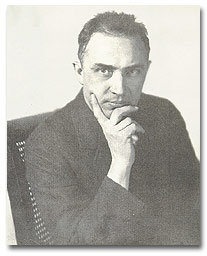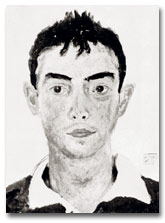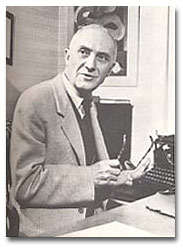
William Carlos Williams was born September 17, 1883 in Rutherford, New Jersey. His father was born in England and his mother was a native of Puerto Rico. They had met when his father was a merchant on the island, where he made a substantial fortune. Rutherford was known as a commuter town for those traveling to New York City.[1] Williams’s father, William George Williams, made it a point to expose his son to classic works of literature and art, including Shakespeare (favorite of both William Carlos and William George), Gilbert and Sullivan, and Dante’s Inferno.[2] This helped to cement Williams’s love of literature.
In 1899, Williams and his younger brother Edward attended Horace Mann High School in New York City (a daily train ride to and from Rutherford) after studying with their mother in Europe for two years. Here, Williams began his extensive study of poetry under William Abbot, who took Williams under his wing to share classic works of poetry in English. This was one of the few classes in which Williams excelled in school, as he graduated Horace Mann with a “C” average in 1902.[3] Despite his grades, he was able to pass an exam that allowed him to go straight to the University of Pennsylvania’s Medical School in Philadelphia, Pennsylvania. His plan was to obtain both an MD Degree and a DDS degree and specialize in oral surgery. While at Penn, he met poet Ezra Pound. He met Pound through a mutual friend after admitting that his real desire was to write poetry. Pound and Williams became great friends for life and great critics of each other’s poetry.[4]
When Williams gradated from Penn with his degree in Pediatrics and Obstetrics (a change from his original Oral Surgery plan), he opened his own practice in Rutherford in 1910. He was known for servicing many from New York City, experiencing their trials and tribulations. He married his wife, Florence, in 1912. They had two children and lived in Rutherford until Williams’s death on March 4, 1963.[5] In his lifetime, Williams was not only an accomplished physician (which allowed him to support his family), but he was also well established as a poet, essayist, short story writer, and playwright. Some of his most famous anthologies include Spring and All (published 1923), Collected Poems 1921-1923 (published 1934), and Adam & Eve & the City (published 1936), as well as prose collections Kora in Hell: Improvisations (published 1957), The Great American Novel (published 1923), and The Voyage to Pagany (published 1928).[6] Williams received the Pulitzer Prize and the National Institute of Arts and Letters’ Gold Medal for Poetry post humorously in 1963.[7]

Regarded as one of the foremost modernist poets, Williams wrote in a unique style known as imagism. Instead of being frank and straightforward with his words, Williams took a “show, don’t tell” approach to his poetry. In other words, Williams would write in a manner that would create mental images of an event in the reader’s mind, and the reader would decipher the meaning behind it for himself/herself. Williams, being a man of the city and a physician to those from the city of New York, used those experiences that he encountered through his patients or through his own time spent in New York to create imagist poems to serve as accounts of these experiences. As M.L. Rosenthal puts it, “Medicine . . . gave him emotional ballast and was itself the source of some of his most impressive writing.”[8] Through some selections, one can see the influence of the city – whether through his own accounts or through the accounts of his patients in Rutherford – had on Dr. Williams.
In the poem “Spouts” (published 1921), Williams takes a description of a fountain outside of Madison Square Garden in New York City and creates a literary “painting” with it, thus expressing imagery about something found in the city. The poem reads:
In this world of
as fine a pair of breasts
as ever I saw
the fountain in
Madison Square
spouts up of water
a white tree
that dies and lives
as the rocking water
in the basin
turns from the stonerim
back upon the jet
and rising there
reflectively drops down again.[9]
Here, the description of the fountain shows the reader Williams’s fascination with the city where he spent his school years. His comparison of the fountain’s spout to trees compares the beauty in nature to the beauty in the city, which alludes to the fact that Williams had a fondness for the city.
With his poem “The Lonely Street” (published 1921), Williams compares two factions with which he is familiar: Children and the streets of New York. Being a pediatrician, he was well aware of child’s play and how children spent their free time. Because he practiced in Rutherford, he often served those who lived and/or worked in New York City. The poem reads:
School is over. It is too hot
to walk at ease. At ease
in light frocks they walk the streets
to while the time away.
They have grown tall. They hold
pink flames in their right hands.
In white from head to foot,
with sidelong, idle look—
in yellow, floating stuff,
black sash and stockings—
touching their avid mouths
with pink sugar on a stick—
like a carnation each holds in her
aahand—
they mount the lonely street.[10]
Here, Williams describe school girls walking the streets of New York in the hot summer months. They carry cotton candy (the “pink flames” from line six and the “pink sugar on a stick-/ like a carnation each holds in her hand” in lines twelve and thirteen). The girls are dressed in white, probably to represent a childhood innocence or purity that Williams could see in the streets. Because of his work with children, he had a special connection to them, as well as the city from which the majority of them came.
Williams not only focuses on the innocent and beautiful of the city, but also on the tragic aspects of city life. New York is known as a city of dreams and a city of broken dreams, and Williams was aware of this when he wrote his poem “The Term” (published 1938), which depicts the image of paper blowing in the street and compares it to life on the streets:
A rumpled sheet
Of brown paper
About the lengthAnd apparent bulk
Of a man was
Rolling with theWind slowly over
And over in
The street asA car drove down
Upon it and
Crushed it toThe ground. Unlike
A man it rose
Again rollingWith the wind over
And over to be as
It was before.[11]
Williams compares the paper to a man and the manner in which a man would react physically to getting hit by a car. Williams knew that the city was often a place of tragedy, and tragedy was something that he would have seen as a doctor. Williams’ reflects on an unhappy turn of events in lines 13-16: “A car drove down/ Upon it an/ Crushed it to/ The ground.” Here, one can see Williams’s disdain for certain aspects of the city, mainly people dying and getting hurt on the streets, which disrupts the beauty and innocence expressed in the two previous poems.

With aspects of Williams’s life and samples of his writing in perspective, one can see how the city had an affect not only on him as a person, but also as a writer. Living in and around New York for most of his life seemed to have a profound effect on his poetry. As a half-Puerto Rican man, Williams was lucky enough not to be shackled by prejudice and discrimination, as many Puerto Ricans were during his lifetime. Instead, he used the urban world around him as inspiration and his drive to be successful, both as a poet and a doctor, to create a legacy for himself that will live on through his writing.